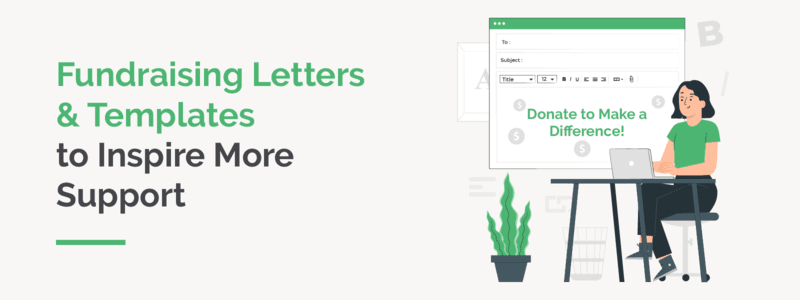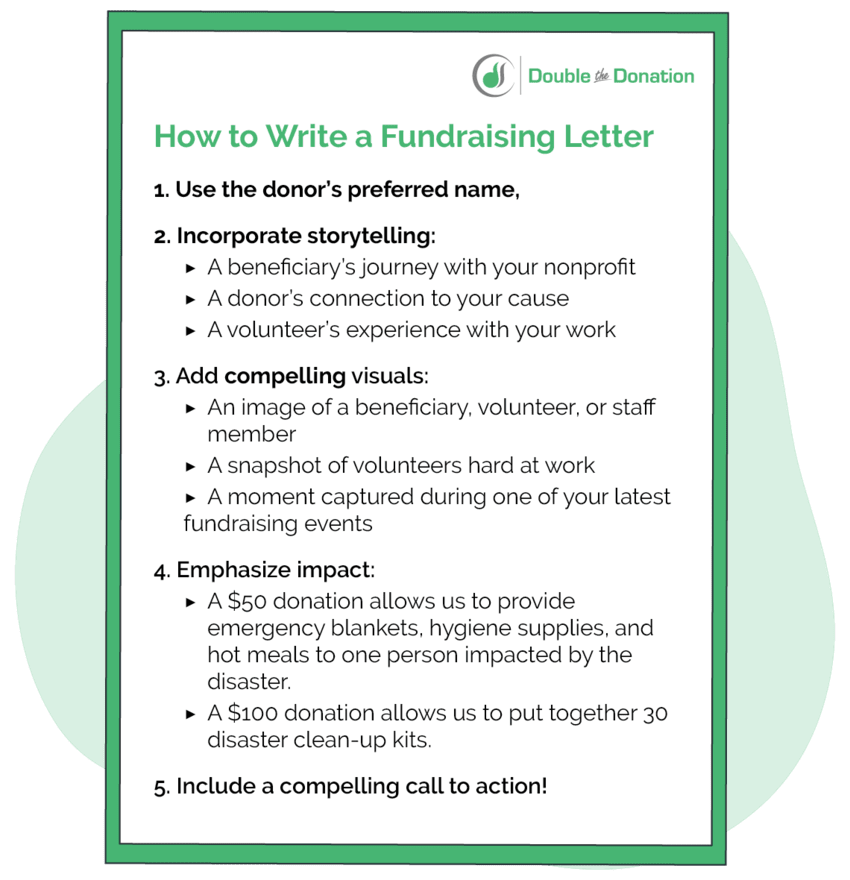

Your nonprofit needs funds to power its mission, but how do you communicate this need to potential donors? Fundraising letters are a time-tested, impactful way to reach out to supporters and encourage them to play a role in your impact.
Whether you choose to send them via email or direct mail, if you’re looking for smart and effective appeal letters, you’ve come to the right place. We’ve compiled common types of donation requests, plus carefully crafted templates that your team can use to jumpstart your outreach.
Here’s what we’ll cover:
With the right tips, tricks, and tools, your team can connect with more donors and cultivate lasting relationships to strengthen your work. Let’s cover the basics of writing fundraising letters, then explore the specific types of requests your nonprofit may decide to send.

Before crafting your letters, you’ll want to know how you’re going to deliver each one. That way, you can tailor the formatting appropriately. Certain outlets lend themselves better to letters than others. Of course, you’ll want to deliver your solicitation letters using each recipient’s preferred contact method. Bearing that in mind, let’s explore the most common channels nonprofits use to solicit donations.
Who doesn’t love receiving a thoughtful greeting card? From special occasions to “just because,” there’s a card for everything! With a bit of creativity, you can elevate your fundraising letters by sending them as digital greeting cards. Each donor will receive a virtual greeting card alongside your letter. Delivering them in this format is more creative and effective than a plain letter.
Here’s a peek into why nonprofits use this approach to drive greater fundraising results:
Not to mention, this approach is extremely cost-effective, eco-friendly, and personable. No need to waste paper or money on printing and postage. You’ll get the speed of email and the authenticity of direct mail!
To leverage this approach, choose an online eCard platform. We recommend using eCardWidget. The platform enables nonprofits to create digital greeting cards that communicate their missions. To fundraise with them, you can either sell them to supporters or send them directly to donors to solicit gifts.

Many nonprofits connect with donors by delivering fundraising letters via email. Regular email communication allows you to build relationships over time by keeping supporters informed about your organization’s initiatives and fostering a sense of belonging to a larger cause.
Through targeted email campaigns, you can reach your entire donor base while customizing solicitation messages to resonate with individual donors. You’ll want to:
The versatility, speed, and cost-effectiveness of email make it an essential tool in your nonprofit’s fundraising and digital marketing arsenal. You’ll have everything you need to deliver thoughtful fundraising letters and drive contributions that support your work.
Deliver your fundraising letters via direct mail to donors who prefer a more personable touch. Known for its authenticity, direct mail allows you to connect with donors on a more intimate level.
Fundraising via direct mail makes it a bit more challenging to segment your outreach, but still take donor-specific details like giving history into account when crafting your letters. Then, you’ll want to vary your approach slightly by including easy response components. For example, include a pre-addressed envelope or QR code that leads to your donation page. This will simplify the donation process, enhancing the effectiveness of your solicitations.
Overall, the tactile nature of direct mail makes it a valuable tool for your nonprofit to engage donors, reinforce its mission, and drive meaningful contributions.
When crafting a fundraising letter for your nonprofit, the key to success lies in not only communicating your funding needs clearly, but inspiring recipients to take action and make a gift. To set your appeal up for success, follow these essential steps:

To make your fundraising appeals stand out from the crowd, consider sending them as fundraising eCards. These online cards provide an efficient, memorable, and sustainable way to engage your supporters—not to mention they’re low-cost.
Now that you have a clearer understanding of what it takes to draft a compelling fundraising letter, let’s take a closer look at some common types and templates that may come in handy:
Nonprofit fundraising letters are typically sent by charitable organizations to individual donors and/or prospects in order to solicit donations for a cause. They can be sent on their own or included in a welcome packet that contains pamphlets, booklets, and additional information.
Typically, an effective donation request letter will include:
Bonus: We suggest giving donors the option to reply to your letters by mailing a traditional check or directing them to give through your organization’s website.
Send your nonprofit fundraising letters to anyone in your network of support, including:
In other words, reach out to anyone who has previously expressed interest in your cause. Tailor your messaging to different groups based on their relationship with your organization. Keep in mind that while older generations of donors may prefer direct mail communications, younger millennials and Gen Z supporters may prefer a digital approach.
You can send nonprofit fundraising letters at any time of the year! However, they are particularly effective toward the end of the calendar year when donors are calculating their pre-tax season finances. People also tend to be more charitable in December, which means that your appeal has a better chance of securing a donation.